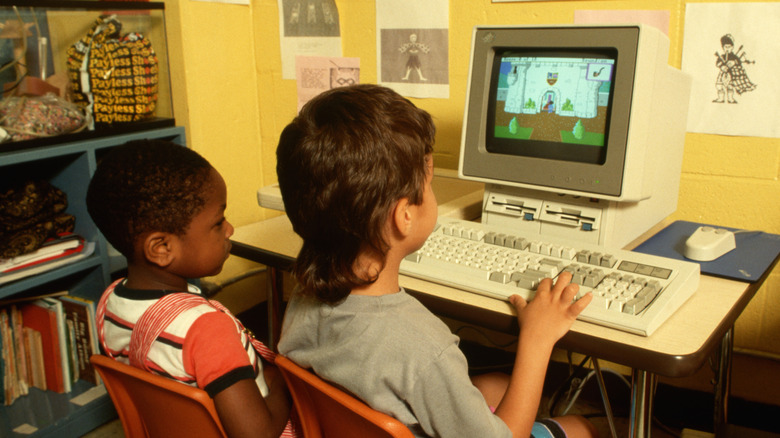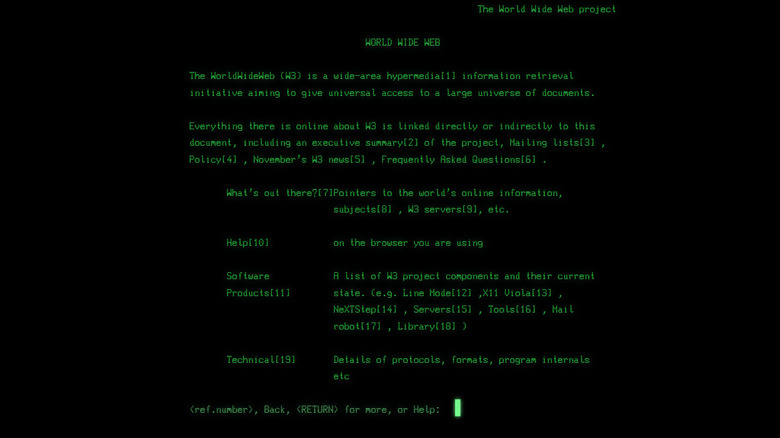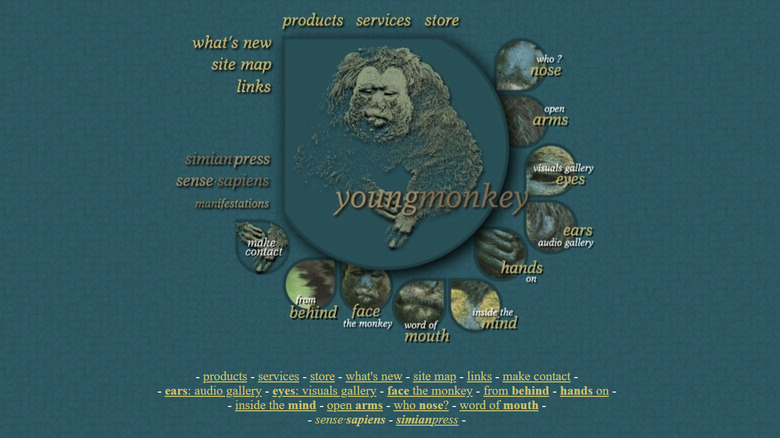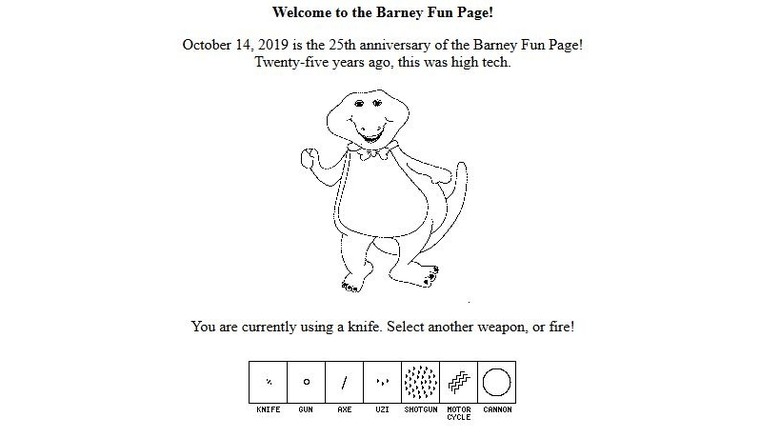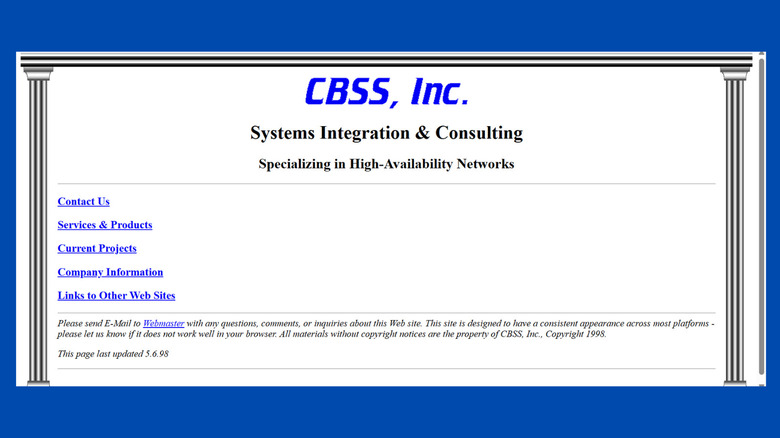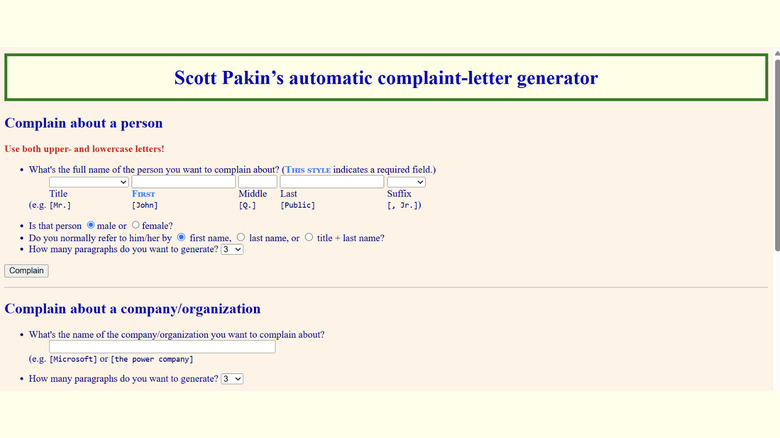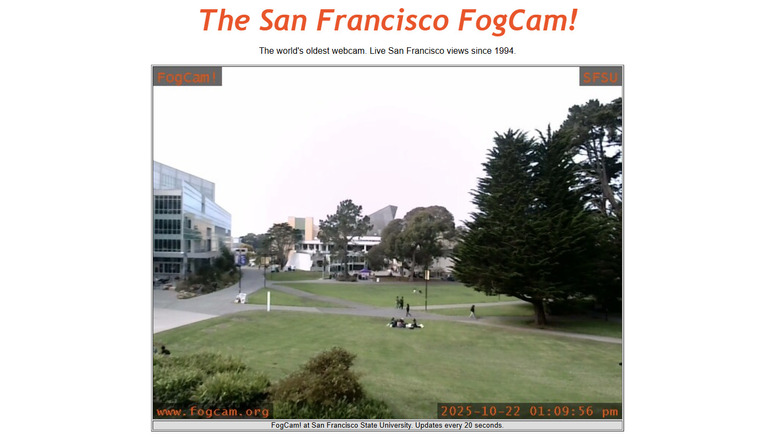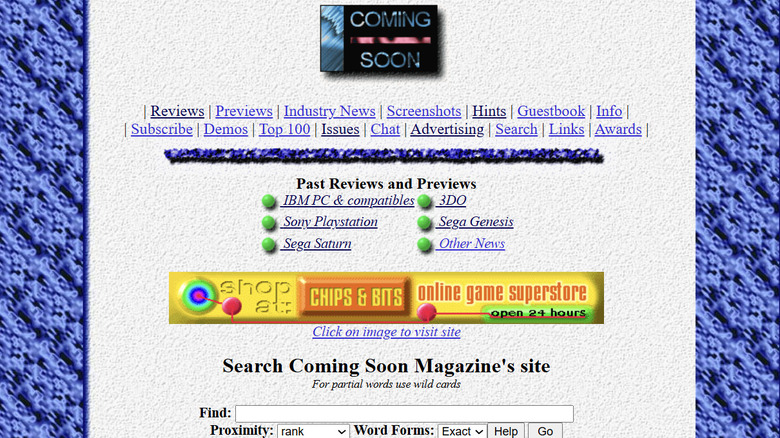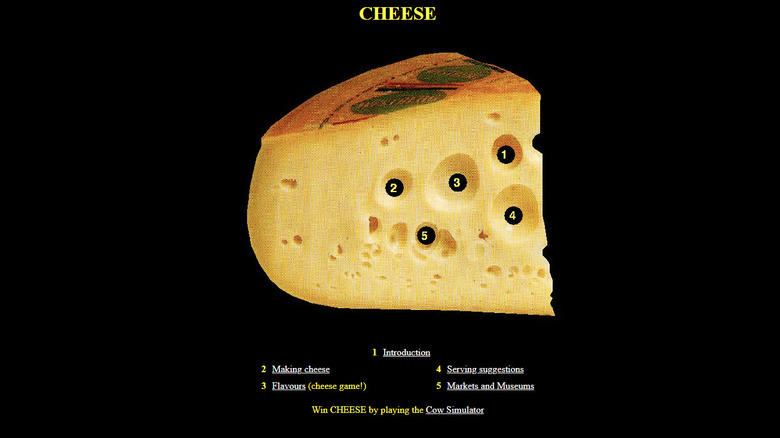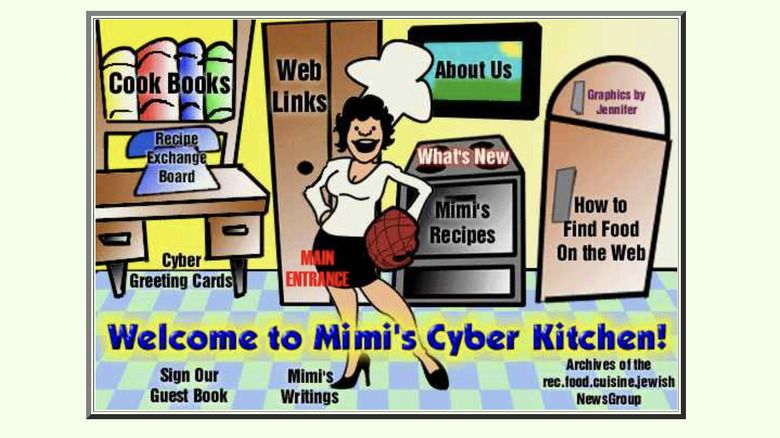These 1990s Websites Are Still Alive And Waiting For You To Explore
The 1990s were a very long time ago, especially on the internet. Back then, the World Wide Web was new, and a lot of people didn't know what to do with it. Most people didn't have online access (only 14% of the U.S. population in 1995), and those who did were usually connecting via Ethernet cables through their phone lines. If you're of a certain vintage, then the screeching sound of the dial-up internet connection will transport you right back to those times. Websites created back in the '90s, like the first Apple.com homepage, might seem amateurish and clumsy compared to what we're used to today. Although technical limitations play a big part in that, there are other reasons why old websites look the way they do. Back then, there were no established design conventions, and everything needed to be hand-coded. Even large companies were often unconvinced of the benefits of having a webpage, and the design was left to software engineers rather than the marketing team.
Not many websites from that era survive. Many — like Amazon and Coke — have been redesigned dozens of times since their early versions. Others just expired. Finding sites that still look and function like they did in the last century is basically a treasure hunt. Someone somewhere must still be paying for the domain. Sites that used static HTML rather than now-obsolete technologies are more likely to still work. However, just because the domain is there, it doesn't mean it has all the security protocols that we're now used to. Many of the sites on this list aren't secure. If you click on them, you'll get a warning message telling you that your connection isn't private. You can override that message by selecting Advanced options, but you're taking a risk by doing so. Proceed with caution.
CERN — The very first website
If you've ever pondered where the World Wide Web began, it was here. This is where British computer scientist Tim Berners-Lee, working at CERN in Geneva, put the world's first webpage online. Back in 1989, Berners-Lee had an idea. What if scientists could easily share information across different computers and institutions? The internet already existed, but there was no simple way to navigate or link documents. So he dreamed up an entirely new system — the World Wide Web — and, by the end of 1990, he had it working. He created the first web server, the first web browser, and the very first website. To do this, he had to invent everything that makes it possible. The protocols and markup languages that web developers use, like HTTP, HTML, and URLs, didn't exist yet. Berners-Lee created them all.
That understated-looking page went live in August 1991 when Berners-Lee announced the project to the public. The site itself explained what the Web actually was and how you might use it. It opened with the line: "The WorldWideWeb (W3) is a wide-area hypermedia information retrieval initiative aiming to give universal access to a large universe of documents." You can still see it today because in 2013, CERN began a project to restore the earliest iterations of the internet, including the original IP addresses and URLs. Like with TimeMap's interactive historical map, this important piece of history is now preserved so we can see where it all began.
Youngmonkey
Most of the early website adopters were universities and science labs. Youngmonkey was one of the first to be there primarily for fun. It went online in 1991 or 1992 (even the website itself is not entirely sure). The website is still there, sporting its design from 1997. It's a collection of digital music, digital art, fiction, reprints of articles, a page offering tech services, and whatever other online odds and ends its creator, Dhomas Trenn, chose to put up there.
The website was first hosted through the University of New Brunswick before moving to its own domain in 1995. Here, you'll find quirky section titles like "Who Nose," "Open Arms," "Word of Mouth", illustrated with an image of a monkey body part. The "Ears audio gallery" link takes you to a collection of ambient and techno sounds created by artists with names like "big SELF" and "noko". The services page offers Streaming Events and Product Sales Manager software, promising "a website based system for selling products of any kind on the internet."
Where is Dhomas now? Was that their real name? Whoever they are, they're difficult to track down. There were later projects like 2005's Rant About It, a forum to anonymously post grievances, and a now-defunct publishing company called Simian Press. However, the internet is strangely quiet about their current whereabouts. Whatever they're doing now, they've earned their place in web history.
The Barney Fun Page
The Barney Fun Page game was originally created in 1994, and it still works. So, if you want to shoot a cannon or an Uzi at a basic black and white image of Barney the Dinosaur, then here's your chance. You can select the weapon of your choice, and the page keeps you updated on how the attack is going, saying encouraging things like "Barney is starting to feel less-than-healthy" and "One more shot oughta do it." You can even carry on shooting Barney after he's dead, and see messages like "Barney is starting to decompose" and "Mmmm, Barney guts." How quickly you kill him is just based on how many goes you have — regardless of which weapon you use or where you fire them. You can kill Barney just as quickly by knifing his toes as you can by firing cannons at his head. In fact, you can just shoot the air around him, and that will see him off too.
The whole thing is in very poor taste and all the funnier for it. Sure, the graphics are basic. Barney doesn't respond to the attack. It's the online equivalent of throwing darts at a picture of someone. But I spent several happy minutes on a thirty-year-old basic game when I could have, I don't know, been creating pictures of mangled Barney corpses with an ChatGPT's free AI image generator. The About page details all the plans the Barney Fun Page creator had for the game, such as making Barney move and improving the graphics. And honestly, why would you want to? If it ain't broke, don't fix it. The game that is. Not Barney. Once I'd finished firing cannons at him, Barney was very broken indeed.
CBSS, Inc.
There's nothing particularly exciting about network consulting firm CBSS's website when you look at it. It's noteworthy because of how early the company entered the game. The website debuted in 1992 and the current version was updated in 1998. Although this list is going to be full of the garish, pixelated, Comic Sans-based monstrosities that people associate with 1990s websites, actually, at the time, most of them looked like this.
CBSS's Network Services & Products page is a time capsule of 1990s corporate tech culture and historic computing terms. It proudly declares partnerships with long-vanished giants like PSINet, "the very first commercial Internet Provider," and offers support for Compaq, Novell NetWare 86, and Windows for Workgroups 3.11 — all recognizable to software geeks who were around at the time. The text is crammed with references to ARCNet, Token-Ring, and Cat. 1–5 cabling, relics of a time when "high-performance network" meant stringing together beige boxes and coaxial cables. Even the navigation feels endearingly literal — a link reading "This will take you Back." wasn't self-aware irony, just a time when users didn't recognize a left-pointing arrow as a back button and web designers had to literally spell everything out.
Scott Pakin's automatic complaint-letter generator
This random complaint generator has been around since 1994 and still works. All you need to do is enter the name of the person (or company) you want to generate a complaint letter about, and it will present you with a wall of Times New Roman text that might include such gems as "Emma has the mien of a scummy plutocrat." The wordiness is part of its joy, each random complaint letter is stuffed full of obscure phrases like "wormy opuscula and cold-blooded, Mephistophelian Bulverism," while not shying away from more basic accusations. "Let's be frank: Emma is a being who invents nothing, originates nothing, and improves nothing."
Although incredibly, its creator is keeping it updated and adding to its vocabulary, the basic look and functionality haven't changed since the 1990s, so it deserves a place here. There are currently 18,400 total entries in the database, which include 470 first sentences, 266 concluding sentences, 5,588 independent clauses, 770 derogatory adjectives, and 190 really long words. Although back in 1999, there were only 6,000 words and phrases, so presumably things got repetitive a lot more quickly. It's nice to think that, alongside everything else that Pakin presumably has going on in his life, he pops in every so often to add some more insults to the program and fix any bugs.
Pakin is a computer scientist from New Mexico, and the '90s theme applies to everything at pakin.org, including a knitting pattern generator and a "handy-dandy" word-filtering program to help you cheat at word games. There's also a collection of Magic Eye pictures, which seems as '90s as you can get. Sadly, most of the content has been created more recently than the typeface suggests, and isn't eligible for the list.
FogCam
The FogCam is the world's oldest webcam. It was set up in 1994 at San Francisco State University, and it's still working today (although the camera itself has been moved around the campus a few times in the last 31 years). It looks like a still image when you first check it out, but, in fact, it updates every 20 seconds. Which is a remarkably long time when you're staring at the screen waiting for it to move. There's no countdown timer indicating when the next update is coming, so it feels just long enough to convince yourself that it's probably broken, then people disappear or a car appears, and the whole thing is magical.
FogCam was created by Jeff Schwartz and Dan Wong in 1994 when they were students at the university. Webcams didn't exist back then, so the men created their own from an old Mac computer and a camera, and wrote the software themselves. The idea was that it would give people an idea of life on campus. It has been in a few different locations, and has variously been used by students to check for available parking spots or keep tabs on the length of the queue at the campus coffee shop. It also achieved a cult following, first for its novelty, then for its longevity.
When, in 2019, its creators announced that they were shutting it down, people got upset, and it was widely reported in the press. The university itself stepped in and said that it would continue to support the running of the camera indefinitely. The tech hasn't been updated, allowing you to enjoy its grainy footage and 20-second updates just as those viewing it in 1994 would have done.
Coming Soon Magazine
The Coming Soon Magazine website was created in 1994 and was last updated in 2000. It's a treasure trove of in-depth reviews of games from the mid to late '90s, focusing on games for PCs, the PS1 (which is worth more than you might think today), Sega Genesis, and its successor, the Saturn, as well as the short-lived 3DO games console. Although the website calls itself a magazine, there's no indication on the site that there was ever a print version. Despite this, the site emulated a magazine publication schedule with separate issues that were published monthly, each containing a mix of reviews, previews, news, and advertorials from games companies. You can also browse reviews alphabetically, so you don't need to go through each issue to check if they reviewed Doom or Tomb Raider.
And while, sadly, there's no Doom review, there is a review of the original Tomb Raider from 1996. It captures the excitement of early 3D gaming and the emerging online culture that surrounded it. The reviewer marvels at the game's 3D graphics, ambient soundtrack, and sophisticated opponents. The site's take on a female protagonist is interesting. On the one hand, it seems to welcome a shake-up to traditional male protagonists, but then it quickly embraces a bit of sexism that demonstrates things really were different 30 years ago. "Since we must watch the character during the whole game, it is much more pleasant to look at a woman."
Dole/Kemp 1996 campaign page
Back in 1996, when Republican senator Bob Dole teamed up with former congressman Jack Kemp to take on Bill Clinton's re-election bid, they launched one of the earliest presidential campaign websites. For some reason, this is still on the Web today, even though the chances of Dole winning the 1996 presidential campaign now are pretty low. The campaign pushed a 15 percent tax cut and traditional Republican values, but it never quite caught fire. Clinton's upbeat message of prosperity in a booming '90s economy proved hard to beat, and Dole's old-school style couldn't compete with the president's charm. In November, Clinton cruised to re-election.
Happily, you can still browse the website to read a timeline of Dole's life, download campaign wallpaper, and check out his wife's Pecan Roll Cookie recipe. There's also a page about "Where Bob Dole Stands on Technology and Internet Issues." Interestingly, with the benefit of hindsight, many of Dole's criticisms of Clinton's policies were pretty justified. For instance, Dole warned that the Clinton administration wanted government access to private encryption keys, a that program was eventually abandoned after public backlash. He also criticized Clinton's push for stricter copyright controls, arguing it would favor corporations over ordinary users. The Digital Millennium Copyright Act of 1998 proved him right in many ways, as it has been widely faulted for limiting fair use and stifling creativity on the internet.
On the site's latest messages section, the most recent update is from November 5, 1996, urging people to go and vote. If you're wondering who on earth, in 2025, is still paying for the dolekemp96.org domain, it appears to be an organization called 4president.org, whose website is a difficult-to-read collection of campaign announcements and collection speeches, dating back to 1960.
Cheese!
This page is part of the Internet 1996 World Exposition website, an online world fair set up when the internet was all new and shiny. There's a lot to explore in its online "pavilions", but the Cheese section is by far the best. It's oddly cagey about who's behind it, but it seems to be run by some sort of Netherlands-based Cheese Marketing Board. It's all about Dutch cheese. If you want information about cheese from other countries, you're out of luck. The home page is simply a big image of cheese and a whole bunch of enticing links, including one that says "Win CHEESE by playing the Cow Simulator." Sadly, the cow simulator is now defunct. There's still more than enough to enjoy here with information about cattle, a history of Dutch cheese-making, and recipe tips.
The most exciting feature is a quiz called "Name That Cheese!" Can you tell your Frisian Clove from your Farmhouse Leyden based on some tiny images? The link to tell you whether you've guessed correctly is dead now, so you'll need to work out for yourself if you got the answers right, maybe by checking out the flavors page or the table of different cheese varieties.
When you've had your fill of Dutch cheese, you can explore the other stalls at the World Internet Exposition website, including Antique Apples of America and one about herbs, but they're not as much fun. Unfortunately, many of the external links are broken. If you wander about, you'll keep stumbling on tantalizing hyperlinks like "PiranhaCam" and "Museum of the Horse" that give you a flavor of the internet in 1996 but no longer take you anywhere.
Mimi's Cyber Kitchen
Mimi's Cyber Kitchen was another participant in the Internet 1996 World Exposition, and it's one of the very few external links that still works. The site was first created in 1995 and is a collection of recipes, tips, and other stuff. Being a web pioneer, Mimi was apparently happy to assist anyone new to the concept. There's a whole page giving people advice on how to find recipes on the Web, including a short explanation of how a search engine works. Mimi recommends search engines like AltaVista — a far cry from Google Gemini and its alternatives — and explains that you can "search the entire world wide web...yes, the whole thing."
The best bit is the section where you can send a cyber greeting card. You can't actually send one because it's broken now, but you can choose all the options. Selecting from the available backgrounds and images is like a field trip into the 1990s. And it was a really clever bit of marketing in the days before social media. You could select a recipe from the site and include it with your personal message and a slightly-animated, pixelated picture of a cat on a purple background, spreading the word about Mimi's website. The recipes themselves are delightfully utilitarian. No chitchat, no photos, just a list of ingredients and what to do with them in a no-nonsense font.
